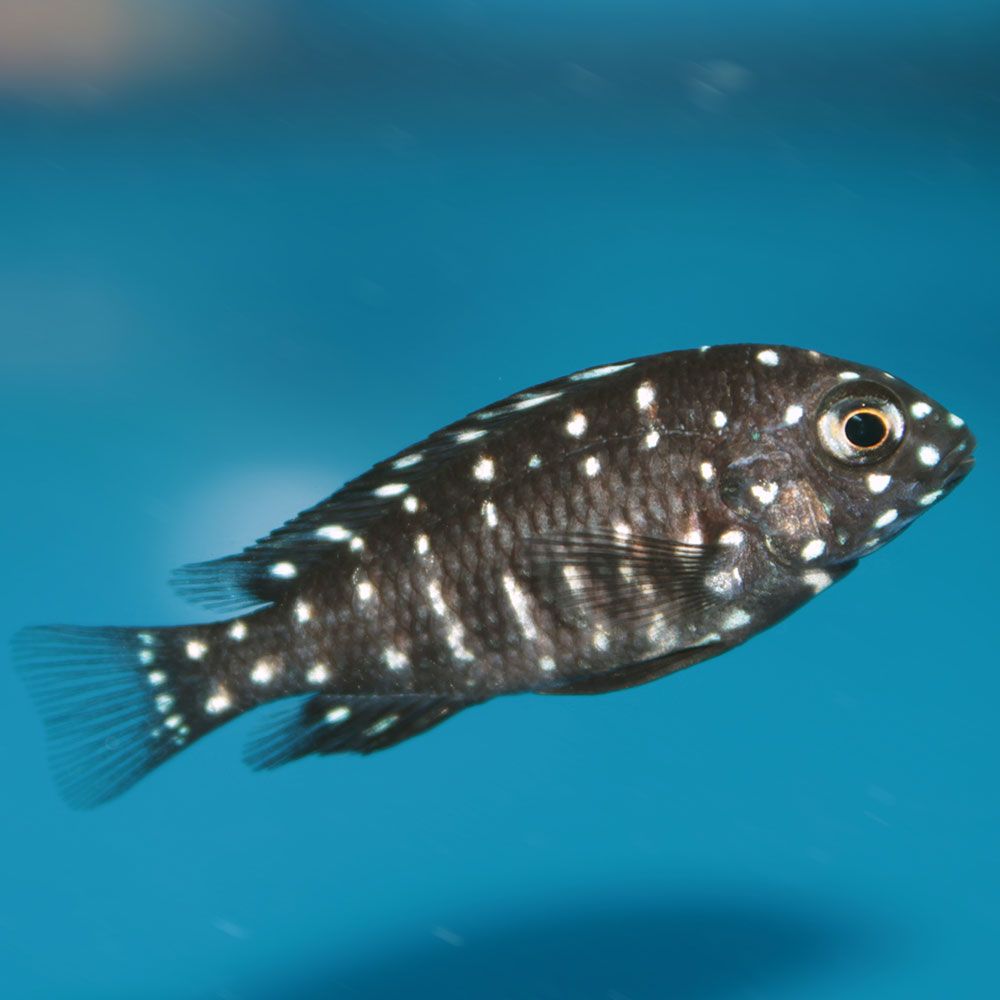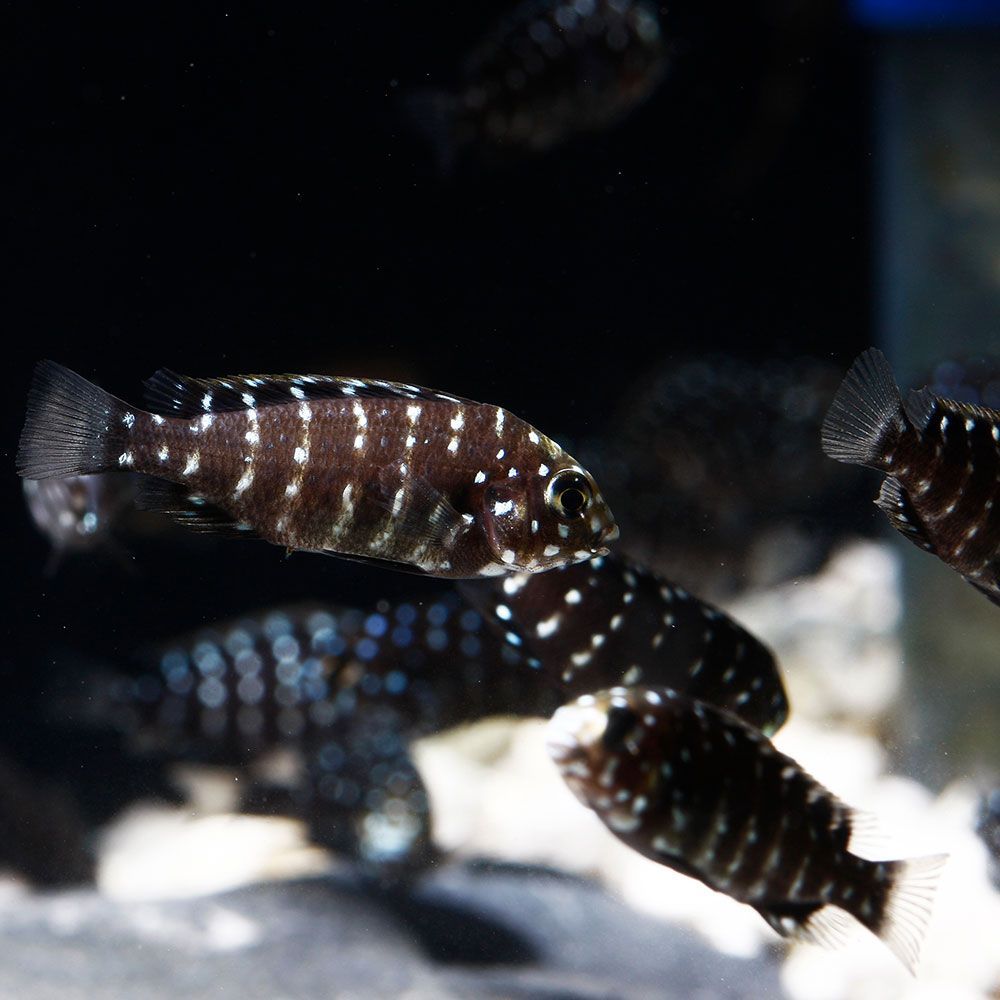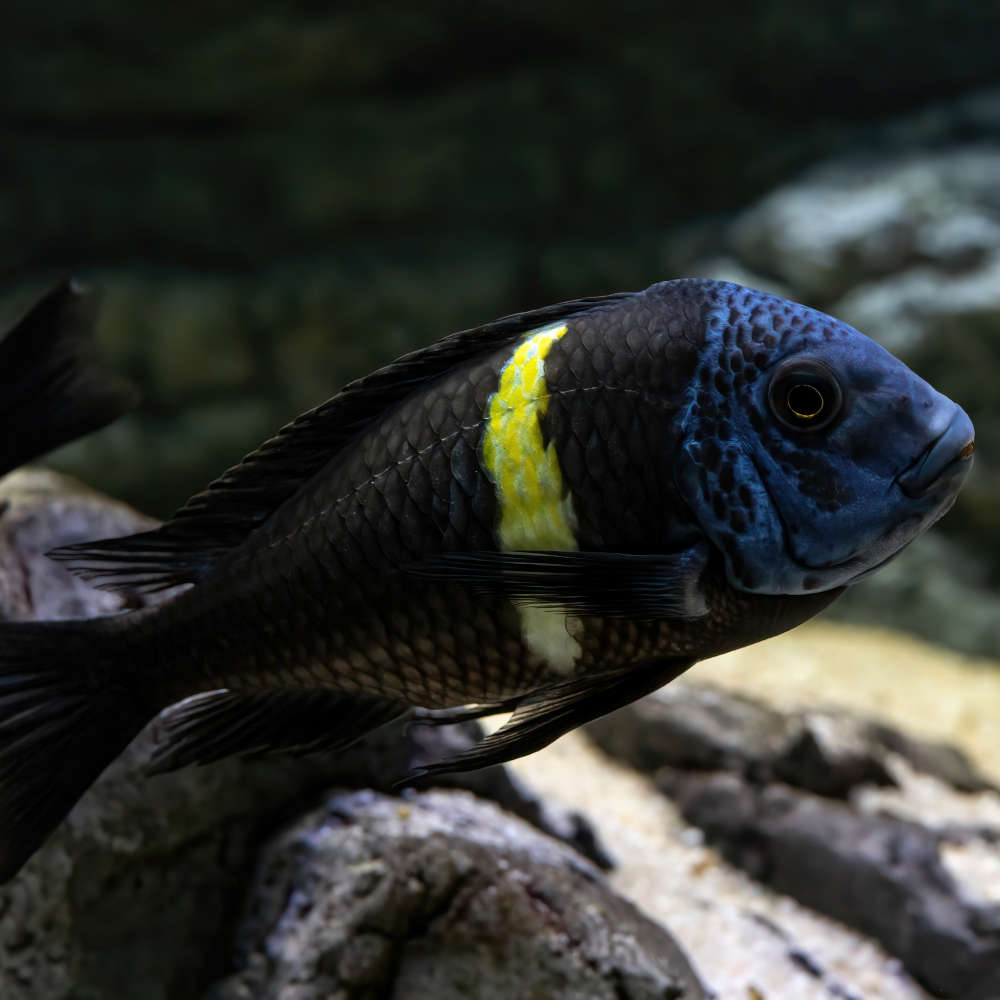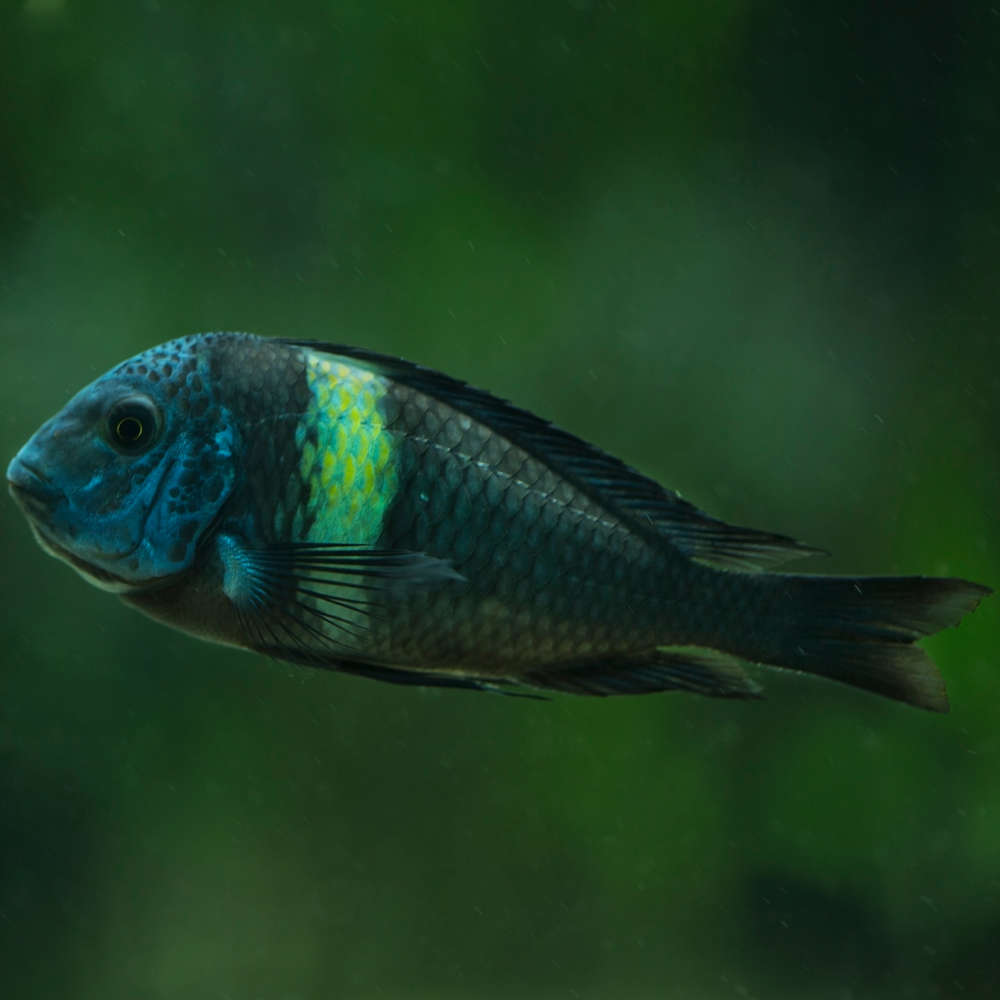The duboisi cichlid is a great option for your freshwater tank, especially if you have some experience in fishkeeping!
The fish has a unique body with an intriguing personality. Though it’s a bit challenging to maintain a duboisi, it’s also pretty fun to level up your skills with it.
This captivating fish also exhibits an almost magical phenomenon of changing colors as it grows.
So, if you’re interested in adding this fish to your tank, keep reading!
What is Duboisi Cichlid?
Duboisi is a freshwater fish that is preferred by experienced fish keepers all over the world for their aquariums.
| Origin | Africa: endemic fish in the northern part of Lake Tanganyika, in countries Burundi and Tanzania |
| Order | Perciformes |
| Family | Cichlidae |
| Scientific Name | Tropheus duboisi |
| Common Names | Dwarf Tanganyikan cichlid, Duboisi Cichlid, White Spotted Cichlid, Blue-Faced Duboisi Cichlid |
| IUCN Red List Status | Vulnerable |
| Appearance | Stocky build, larger head, narrowing towards the tail, and a fan-shaped caudal fin. Black bodies and fins with a bluish head featuring a bold yellow band around their middle. |
| Size | Up to 12 cm (5 in) |
| Lifespan | Usually up to 5-8 years in captivity, Upto 12 years with the best care |
| Temperament | Moderately aggressive, especially during the breeding season |
| Tank Level | Primarily bottom-dwellers |
| Water Temperature | 73-82 °F (23-28 °C) |
| pH Level | 7.8 – 8.8 |
| Water Hardness | 15-25 dGh |
| Care Level | Moderate |
| Minimum Tank Size | 75 gallons tank for 12 diboisi cichlid with only one adult male. For a group with more than one adult male, 125 gallons tank. |
| Tank Environment | Plenty hiding and swimming spaces, sandy bottom of aragonite or small-sized gravel. |
| Diet | Omnivorous in captivity, herbivorous in the wild |
| Tank Mates | The best approach is to keep Duboisi Cichlids in a species-specific tank with a sizeable group comprising at least 11 females and one male |
What is the Natural Habitat of Duboisi Cichlid?
The duboisi cichlid, an endemic fish of Africa, thrives naturally in the tropical freshwater of the northern part of Lake Tanganyika, which spans across the countries of Burundi and Tanzania.
This species mainly inhabits the rocky coastal waters of the lake. They feed on algae attached to the rocks, and their natural depth range reaches up to 30 meters.
Four distinct subpopulations can be found in different parts of the lake, namely Maswa, Kariliani Island, Bemba, and Kigoma.
They are often observed seeking refuge under rocks and creating caves, which they use to establish territories and defend against intruders.
Duboisi cichlid has been assessed for the IUCN Red List of Threatened Species in 2006 and is listed as Vulnerable under criteria D2.
This status indicates a high risk of endangerment. Strict conservation measures are essential to protect their populations and preserve the unique ecosystem of Lake Tanganyika.
Which family does Duboisi Cichlid belong?
This Duboisi cichlid belongs to the family Cichlidae and the order Perciformes. It is scientifically known as Tropheus duboisi.
It is also commonly referred to as the duboisi cichlid or white spotted cichlid due to the prominent white spots adorning its dark body.
Additionally, it may also be known as the blue-faced duboisi cichlid due to the bluish coloration on its head, which is more pronounced in mature adults.
Another common name is dwarf Tanganyikan cichlid.
Fun Fact: The scientific name of this fish, ‘Tropheus duboisi‘ comes from the Greek word “Tropaion” which means trophy.
How does Duboisi Cichlid look?

The Duboisi Cichlid has spots on its whole body and undergoes color metamorphosis during its whole life.
What is the size of Duboisi Cichlid?
Duboisi is a moderate-sized fish that can reach a length of approximately 4.7 to 5 inches (12 cm) in an aquarium environment.
Males tend to grow slightly larger than females and reach their full size and display their colors sooner.
Juvenile fish available at stores are about 8 cm (1.5 to 2.5 in).
What is the color of Duboisi Cichlid?
The cichlid experiences a remarkable color metamorphosis during its life cycle. Young ones exhibit charming jet-black bodies adorned with white to bluish spots arranged in vertical rows.
This gradually fades as they mature into adults. Adult duboisi cichlids develop a slate-blue face and a distinct white-to-yellow band behind the pectoral fins.
The head gradually turns bluish, earning them the name blue-faced duboisi cichlid.
The duboisi cichlid also has four naturally found geographical variations, each with distinct features.
- The Karilani or Narrow Band Duboisi cichlid hails from Karilani Island, Tanzania. It showcases a distinct narrow white mid-section band on its dark slate to an almost black body.
- The Kigoma cichlid is from Kigoma, Tanzania. It boasts a broad white mid-section band, though not as wide as the “Bemba” variety.
- The Maswa or Malagarazi originates from Cape Kabogo, Tanzania, a striking broad yellow mid-section band adorns its captivating appearance.
- The Bemba cichlid is native to Bemba, Congo. It proudly displays a wide white mid-section band, making it stand out among its counterparts.
Each unique variety showcases fascinating color patterns, making them captivating additions to any aquarium.
What are the features of Duboisi Cichlid?
Duboisi has a stocky build, with a relatively larger head in proportion to its body, tapering towards the tail. Its caudal fin is fan-shaped.
As a member of the Cichlidae family, these fish share common characteristics, such as a single nostril on each side of the head and an extra set of jaws in their throats known as pharyngeal jaws.
What is the difference between a male and female Duboisi Cichlid?
Males have an upturned nose, bolder colors, and a deeper body. On the other hand, females boast a greater slope and rounded nose, appearing more streamlined.
The male fish is also slightly larger than the female fish.
What is the behavior of Duboisi Cichlid in an aquarium?
Duboisis are known for their aggressive and territorial behavior. They may especially display violent behavior if they lack adequate swimming space or are provided with inappropriate food.
It is recommended to house them in a separate tank to avoid conflicts with other fish and maintain their well-being.
What is the lifespan of Duboisi Cichlid?
These cichlids generally have a lifespan of 5-8 years, but with a suitable environment and proper diet, they can survive up to 12 years.
How to Take Care of Tropheus Duboisi Cichlid?

If you can’t wait to welcome this captivating fish into your aquarium, let’s start creating its ideal habitat!
What is the tank size required for Duboisi Cichlid?
For a group of 12 duboisi cichlids, with one adult male, a spacious 75-gallon tank is recommended, allowing them enough room to roam and explore.
However, if you plan to keep more adult males, opt for a 125-gallon tank. This will help them establish their territories and reduce potential conflicts.
What is the water chemistry for Duboisi Cichlid tank?
The water quality can significantly influence your duboisi’s health. To ensure its longevity, maintain the following water parameters.
- pH Levels: 7.8-8.8
- Water Temperature: 73-82 °F (23-28 °C)
- Water Hardness: 15-25 dGh
- Ammonia: 0 ppm
- Nitrite: 0 ppm
- Nitrate: Below 20 ppm
What is the tank environment needed for Duboisi Cichlid?
Now, to create a safe and joyful environment for your fish, here’s a comprehensive guide to help you achieve just that!
Do you need substrate for Duboisi Cichlid?
The ideal substrate is sandy or very small-sized gravel. The substrate should allow for easy digging and foraging, reflecting the fish’s natural behaviors.
You can also opt for African cichlid-specific substrates or marine Aragonite substrates. This helps maintain pH levels between 7.8 and 8.8, which mimics their natural environment in Lake Tanganyika.
Do you need plants for Duboisi Cichlid?
Plants are a must-have in this tank to help baby fish survive. But be careful, as the fish may munch on some plants.
Consider tough plants like Anubias, Java Fern, Bolbitis, and Cryptocoryne that can handle such aggressive behavior. You can also consider hardy species like Swordplants and water ferns.
While not completely cichlid-proof, these plants can improve your aquarium and provide a nice environment for your fish.
If you’re concerned about plants getting eaten, you can also use well-rooted artificial plants to keep the tank’s visuals intactwithout risking plant damage.
What type of lighting is needed for Duboisi Cichlid?
Use moderate to strong lighting to showcase their vibrant colors. While normal lighting is acceptable, excessive brightness will boost algae growth. And this African cichlid loves to munch on algae!
Standard aquarium lights or energy-efficient LEDs will work well.
On the other hand. low-level lighting will promote their natural digging and sifting behavior.
Strike a balance to ensure a healthy and visually appealing environment for your cichlids.
What is the décor that is needed for Duboisi Cichlid?
Incorporate cave-like structures where fish can retreat when they feel threatened or is ready for breeding.
To replicate their native habitat, add driftwood and smoothened rocks. Don’t overcrowd the tank as they need open swimming areas. Ensure all decorations are safe for aquarium use.
Place all decorations in a well-planned manner to make it visually appealing and secure for your cichlids. That will promote their happiness and overall health.
You can also choose a hardscape with rocks containing calcium carbonate to make the water hard. Arrange the hardscape to create territories for the fish and to keep plants in place.
What type of filter is needed for Duboisi Cichlid?
To keep your duboisi cichlid tank clean and healthy, get a reliable oxygenating filtration system to keep up with their high waste production.
Power filters that incorporate biological, mechanical, and chemical filtration work best for them.
Maintain well-buffered water with regular small water changes. You can use chemical filtration with crushed coral or coral sand layers. Hydra filter and bacterial inoculation are recommended for optimal results.
What is the water flow rate required for Duboisi Cichlid tank?
Duboisi cichlids are lively swimmers and adapted to Lake Tanganyika water conditions. So, if you want them to thrive, it’s essential to provide good water movement.
Proper water flow aids gas exchange and boosts filtration. It also helps the fish’s healthy growth, muscle development, digestion, and metabolism.
However, be cautious not to create excessive turbulence with a powerful filter, as it may affect the fish’s well-being.
Fish Care Tip: To maintain a clean and stable environment in the tank and minimize the risk of diseases, aim to replace around 20% to 25% of the water every two weeks.
What do Duboisi Cichlid eat?

Duboisi cichlid is primarily an omnivore. However, it mainly consumes herbivorous foods in the wild, like aufwuchs, tough algae attached to rocks, along with microorganisms.
In the aquarium, they should be given a high-fiber diet. Some great choices are:
- Spirulina-based flakes and pellets
- Spirulina-based pellets
- Spinach
- Romaine lettuce
- High-fiber foods
- Live foods (Cyclops and Mysis)
- Frozen brine shrimp
- Frozen plankton
- Vitamins and supplements
But avoid the following foods:
- Soft or slimy foods
- Tubifex
- Brine shrimp
- Beef heart
- Mosquito larvae.
Feed live foods and proteins sparingly, as overfeeding may lead to bloating due to their long intestinal tract.
When using pellets, briefly submerge them before feeding to prevent air from getting trapped in the fish’s belly.
Offer small pinches of food three times a day to maintain water quality and avoid overfeeding. Consider adding vitamins and supplements to their diet for overall health.
What are the tank mates for Duboisi Cichlid?
Duboisi cichlids have an aggressive nature and tend to be territorial, so compatible tank mates can help reduce stress and conflicts.
To maintain a harmonious aquarium environment, here are some ideal tank mates:
- Peacock cichlids
- Fontosa cichlids
- Red zebra cichlids
- Venustus cichlids
- Buffalo head cichlids
- Electric yellow cichlids
- Cuckoo catfish
- Acei cichlids
- Demasoni cichlids
- Blue dolphin cichlids
- Rusty cichlids
- Tanganuikan goby cichlids
- Sardine cichlids
- Julidochromis species
- Eretmodus species
- Cyprichromis species
- Paracyprichromis species
Which tank mates to avoid for Duboisi Cichlid?
But you must avoid the following to prevent any loss:
- Peaceful species– theymay be relentlessly harassed,
- Smaller species– they may end up becoming prey.
- Weak larger species– they won’t be able to defend themselves against these cichlids.
- Shy species- they can feel anxious due to duboisi’s high activity levels
- Slower species- they can’t escape if chased or attacked
Note: In my experience, you must not introduce new individuals into an established community of these cichlids. They don’t welcome new members and may get aggressive with them.
What are the Common Diseases that Duboisi Cichlid can Acquire?
Duboisi cichlids are relatively hardy and disease-resistant fish when provided with proper care and a suitable environment. But here are a few diseases you must be careful about.
| Disease Name | Causes | Symptoms | Treatment |
|---|---|---|---|
| Tuberculosis | Bacterial Infection | No signs detected Deaths of multiple fish Positive testing for fish tuberculosis | No treatment Only supportive care Prevented by: Quarantine new fish before introducing into the tank. Sterilize tank decor and thoroughly clean food |
| Malawi Bloat | Bad diet, overfeed, too much salt in water, stress, bacterial infection | Rapid breathing, decreased appetite, abdomen swelling, string-like feces, hiding, poor appetite | Change the water in the aquarium, treat the tank with Metronidazole, and remove activated carbon from the filter. |
| Swim Bladder Disease | Bacterial infection, high nitrate concentration, sudden temperature change, injury, secondary disease, or a poor diet. | Difficulty submerging, buoyancy regulation issues | Diagnose and treat the underlying ailment; diversify diet with high-fiber foods like spinach or peas to relieve constipation. |
| Ich (White Spot Disease) | Parasite infestation | White dots on fins, body, appetite loss, or head, clamped fins, lethargy, respiratory trouble, flashing. | Salt bath, increase water temperatures, ich medicines, or raise tank temperature levels. |
| Gill Flukes | Parasitic worm affecting gill membranes. | Gasping for air, rubbing body on objects, red gills. | Add aquarium salt to the water and slightly increase the tank temperature. |
| Hexamita (Hole in the Head Disease | Parasite infestation. | Depression of fish’s head, loss of appetite, weight loss, lesions on the lateral line. | Improve water quality, and use antibiotics to remove parasites. |
| Columnaris | Bacterial infection. | Sluggishness, reduced appetite, patches of gray/white, and fraying of fins. | Improve the quality of water, give antibiotics, minimize stress |
| Fin Rot | Bacterial infection | Sluggishness, decreased appetite, deterioration and/or splitting of fins, and changes in fin coloration. | Enhance the quality of water, eliminate items causing physical harm, and administer antibiotics. |
How to breed Duboisi Cichlid in an aquarium?
With proper conditions, right knowledge, and care, you can easily breed this fish in an aquarium. But first, let’s prepare well.
Which Breeding Tank is best for Duboisi Cichlid?
A separate breeding aquarium is recommended for successful breeding. It will protect the fish from potential predators and disturbances. In a 40-gallon or larger tank, add enough caves, rocks, and PVC pipes. Maintain ideal water quality.
What are the Mating Conditions required to breed Duboisi Cichlid?
Males are polygamous, territorial and should be given enough space to establish their territories. Have at least 6-10 females per male in the tank. It also reduces male aggression towards females during the mating process.
The species needs 14 months to mature sexually, so choose your specimens accordingly. Keep the fish on a balanced and nutritious diet to condition them.
Monitor male aggression towards females and take necessary actions to maintain a harmonious environment for breeding.
Mating Ritual & Spawning
The male fish is usually eager to mate, but females take time to get into the breeding condition.
When a female is ready to spawn, it signals the male to release milt into its mouth to fertilize the eggs, as the species is a mouthbrooder.
The female then carries the fertilized eggs in its mouth for about four weeks until they mature. The female cichlid can carry 5 to 15 small, round, and semi-transparent eggs in its mouth at once.
When to remove a female Duboisi Cichlid from the tank?
Once the female has eggs in her mouth, transfer her to a separate tank without predators to protect the eggs.
If stressed or harassed, the female may release the eggs prematurely, interrupting the breeding process. Remove stress-inducing factors from the tank to prevent premature egg release.
Or you can remove the female fish with eggs to a different tank. However, when the fish is reintroduced to the tank, keep the lights out and cover it with a black blanket for a few hours. This will distract the group from her return, and they won’t bully her.
Fry Development
After hatching, the female fish provides initial care for the fry. She occasionally takes them back in her mouth to give them comfort. If she’s in the breeding tank with the rest of the group, she also protects the fry from predators this way until they can protect themselves.
Introduce appropriate baby food eventually, as the fry is big enough to accept them. You can feed them microworm and brine shrimp.
Breeding Tip: Don’t try to breed the fish in a community tank. But in case of spontaneous unsuspected breeding, remove Plecostomus (if any). Otherwise, Plecostomus will consume the fry at night.
How many Duboisi Cichlid should you buy?
Buy a group of 15-20 duboisi cichlids to create a more harmonious environment in your aquarium.
Otherwise, in smaller groups of 5-6 cichlids, they may struggle to establish territories and exhibit aggressive behavior towards each other. This can cause potential fatal fights.
A word from FishInAquarium
A bunch of duboisi cichlids in your aquarium adds a flush of stunning color to your aquarium and also gives your fishkeeping skills a ground to prosper.
With that said, we hope you’re bringing this fish. And if you found this article helpful, share it with fellow fish enthusiasts.
If you encounter any challenges or have questions during your journey with these captivating fish, don’t hesitate to drop an email. We’ll be more than happy to assist you along the way!


